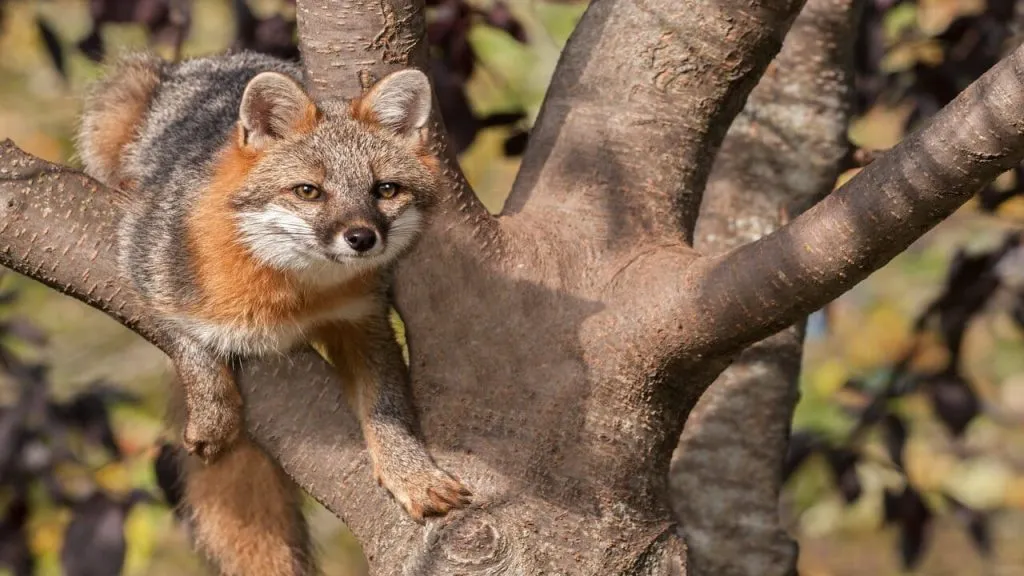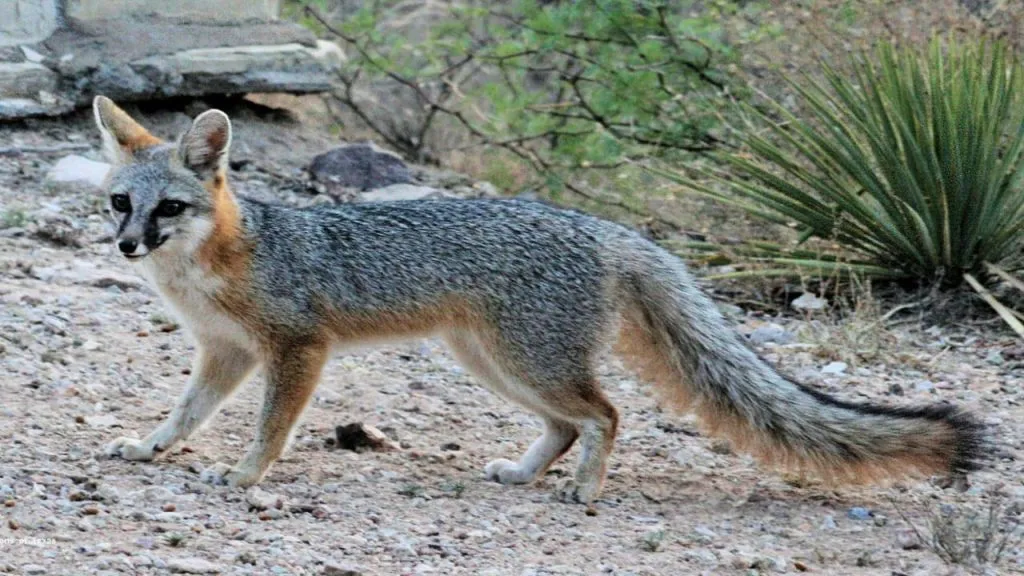As an Amazon Associate I earn from qualifying purchases.
Gray foxes typically measure between 6 to 8 inches in length, with tails about half the length of their bodies.
They weigh around 10 to 15 pounds, with males generally larger than females.
Their legs and feet are covered in black fur, and their tails have black tips. Their backs and sides feature reddish-brown fur, while their chests and bellies are white.
These foxes inhabit forests, woodlands, and brushy areas across North and South America, including parts of the United States, Canada, and Mexico.
While primarily nocturnal, they can be active during the day on occasion.
As omnivores, gray foxes consume both plants and animals. In the wild, they feast on rabbits, squirrels, mice, and other small mammals, alongside fruits and vegetables.
They’re known for their tree-climbing abilities, which they use to reach food sources. When near human habitats, gray foxes may scavenge garbage or pet food.
In this blog post, we’ll discuss what gray foxes eat in the wild, their dietary habits in desert regions, and what baby gray foxes eat.
So let’s get started and learn more.
What do Gray Foxes Eat In the Wild: Complete List of Food

In their natural habitat, grey foxes (Urocyon cinereoargenteus) are omnivores, meaning they consume a wide variety of plants and animals depending on what’s available and the time of year.
They mostly go for small mammals like mice, voles, rats, squirrels, and rabbits because they’re easy to find and catch.
Gray foxes are also quite fond of birds, ranging from tiny songbirds to larger ones like chickens.
They’re skilled climbers, so raiding bird nests is no problem for them. During warmer months when insects are abundant, they’ll munch on grasshoppers, beetles, and crickets.
Besides meat, gray foxes enjoy fruits such as berries, grapes, and apples, especially in late summer and fall when these treats are ripe.
Sometimes they’ll scavenge dead animals or feast on leftovers from other predators, adding even more variety to their diet.
Thanks to their ability to adapt to different environments like forests, grasslands, deserts, and even suburban areas, gray foxes have plenty of food options.
This adaptability is crucial for their survival across North and Central America.
In essence, grey foxes are clever predators with a knack for finding food wherever they go, making them well-suited to thrive in diverse ecosystems.
What do Gray Foxes Eat in the Winter?
In winter, when it’s cold and food is harder to find, gray foxes change what they eat and how they hunt.
Although they still like the same kinds of food as they do in other seasons, they might have trouble catching their usual prey because it’s hiding or not moving around much.
Gray foxes usually eat small animals like mice, rats, rabbits, and other rodents all year round.
But in winter, these animals might be harder to find because they’re hiding deeper in the ground to keep warm.
To deal with this, gray foxes might change how they hunt.
They might start looking for dead animals left by other hunters, or they might search for rodents hiding in their burrows.
Also, gray foxes eat plants sometimes. In winter, when fruits and berries aren’t available, they might eat roots and other parts of plants to stay full.
Gray foxes are smart and flexible, so they find ways to survive during the winter.
Even though it’s tough to find food, they manage to stay fed until spring comes and more food becomes available.
Understanding how gray foxes adapt their diet in winter sheds light on their resilience and survival strategies. Now, let’s explore what gray foxes eat in desert environments.
What do Gray Foxes Eat in the Desert?
In the desert, gray foxes mainly go after small animals that are used to living in dry places.
These can be critters like desert rabbits, kangaroo rats, mice, and packrats, which are tough enough to handle the harsh desert conditions.
Aside from going after small mammals, gray foxes also hunt for reptiles like lizards and snakes.
These reptiles are all over the desert and give the foxes a good source of food, especially when other animals are hard to find.
Gray foxes aren’t picky eaters; they’ll also snack on bugs like grasshoppers, beetles, and scorpions found in the desert.
When there’s not much food around because of drought or other reasons, they’ll even scavenge for dead animals or munch on plants like fruits, seeds, and leaves to keep themselves going.
What do Baby Gray Foxes Eat?
Baby gray foxes, also known as kits, start by drinking their mother’s milk just like most mammal babies.
As they grow a bit older and start to explore the world outside their den, they slowly begin to eat solid food.
Their mom shows them how to hunt and what to eat. At first, they nibble on easy-to-chew foods like insects and small rodents that their mom brings back to the den.
As they become more experienced, they start hunting by themselves and eating the same types of foods that adult gray foxes eat, such as small animals, birds, reptiles, insects, and fruits.
So, baby gray foxes eat a mix of their mom’s milk and whatever their mom finds or teaches them to catch until they’re big enough to hunt by themselves and enjoy a wider variety of foods.
How to do Gray Foxes Hunt: The Hunting Technique
Gray foxes are clever hunters that use different methods to catch their food.
They sneak up on their prey by moving quietly through the bushes and trees, using their sharp senses to find them.
Sometimes they patiently wait for the right moment to jump out and catch their meal by surprise.
With their strong legs, they can leap far and quickly grab their prey, usually aiming for the neck or head to stop it from getting away.
They’re also good at chasing after smaller animals for short distances and can climb trees to get to their food or escape from other animals.
If their prey is hiding underground, they’re skilled diggers and can uncover it easily.
These techniques help gray foxes find food in many different places and environments, making them successful hunters in the wild.

What Eats Gray Foxes: The Predators of Gray Foxes
Gray foxes may be good at hunting, but they have enemies too. Here are some animals that can be a danger to gray foxes:
1. Coyotes: Coyotes are bigger and stronger than gray foxes, and they often compete with them for food and places to live.
Sometimes coyotes even hunt gray foxes if there’s not much other food around.
2. Bobcats: Bobcats are sneaky hunters that go after small animals, including gray foxes. They’re good at surprising their prey, which makes them a big threat to gray foxes.
3. Large Birds of Prey: Birds like great horned owls and golden eagles can also be dangerous to gray foxes, especially young ones.
These birds hunt from the air and can catch gray foxes when they’re not paying attention.
4. Mountain Lions: In places where gray foxes and mountain lions live in the same area, mountain lions might hunt gray foxes too.
Mountain lions are strong predators and can take down even bigger animals like gray foxes if they get the chance.
5. Humans: Although people aren’t natural predators of gray foxes, they can still cause them harm.
Humans can destroy gray fox habitats by building cities or roads, and sometimes they hunt gray foxes for their fur or because they see them as pests.
Despite facing all these dangers, gray foxes have ways to stay safe and survive in their homes.
They’ve learned to be careful and find ways to avoid getting caught by predators or harmed by people.
Facts about Gray Foxes
Gray foxes are pretty amazing creatures with some cool traits:
1. Great Climbers: Unlike other dogs, gray foxes can climb trees.
They’ve got strong claws and flexible bodies that help them scamper up trees to find food or escape from other animals.
2. Night Owls: Gray foxes are most active at night.
They like to do their hunting and move around when it’s dark outside, which helps them stay safe from other animals that might want to eat them.
3. Talkative Bunch: Gray foxes make lots of different sounds to chat with each other.
They bark, yip, growl, and even scream to send messages to other foxes nearby.
4. Family Folks: Even though gray foxes usually hang out alone, sometimes they form small families with a mom, dad, and their babies.
These families work together to find food, take care of the kids, and keep their home safe.
5. Eat Anything: Gray foxes aren’t picky eaters.
They’ll munch on all sorts of things like small animals, birds, bugs, fruits, and even some plants, depending on what’s around.
6. Flexible Living: Gray foxes can live in lots of different places, like forests, fields, deserts, and even neighbourhoods.
They’re good at adapting to wherever they find themselves.
7. Smart Hunters: Gray foxes are sneaky hunters. They use tricks like hiding, jumping, and surprising their prey to catch food.
They’re patient and clever when it comes to getting their next meal.
8. Defending Their Turf: Gray foxes mark their territory with smelly signals and use sounds and body language to tell other foxes to stay away.
They protect their space, especially when it’s time for babies to be born.
These facts show just how special gray foxes are and how they fit into their homes all across North and Central America.
Conclusion
To sum up, gray foxes are clever and flexible hunters that have thrived in various habitats throughout North America.
While they’re usually not a bother, they can become a nuisance if they rummage through garbage bins or bird feeders.
If you’re dealing with issues caused by gray foxes, it’s wise to reach out to a wildlife control specialist for assistance.
Thank you for reading! I hope this article provided helpful insights and improved your understanding of these captivating animals.
FAQ’s:
Yes, gray foxes do eat eggs. They are omnivores and will consume bird eggs when they find them.
Foxes are opportunistic eaters, but their favorite foods typically include small mammals like rabbits, rodents, and birds.
They also enjoy fruits, berries, insects, and carrion.
Yes, gray foxes may eat apples if they come across them, along with other fruits and berries.
However, their diet primarily consists of small mammals and other prey items.
In the wild, gray foxes typically live between 6 to 8 years.
However, in captivity or under favorable conditions, they may live longer, reaching up to 10 to 12 years.
Amazon and the Amazon logo are trademarks of Amazon.com, Inc, or its affiliates.

